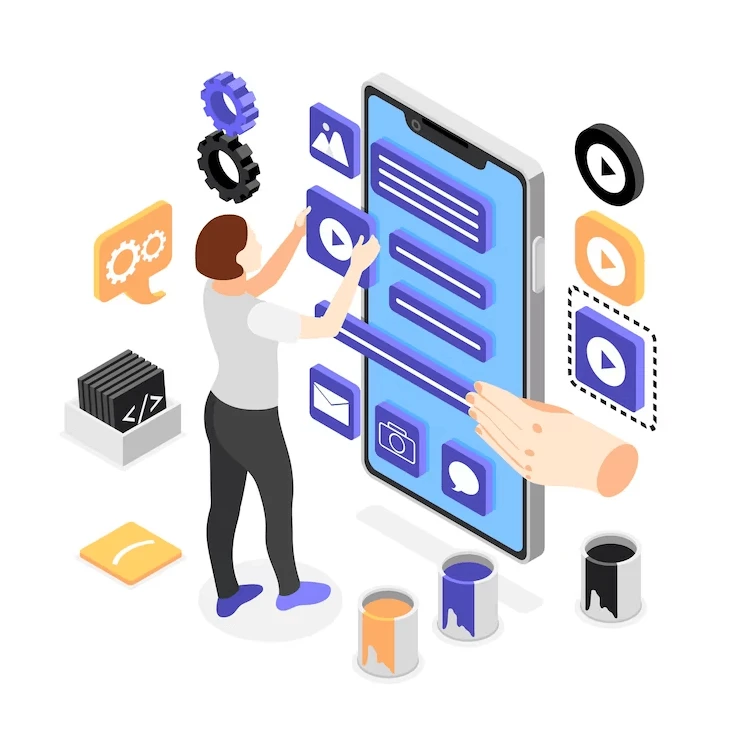Table of Content
Discover the Similarities and Differences between Low Code and No Code Platforms
Today, there is a massive demand for automation, especially in the tech sphere. People are looking to save the effort and the time that doing it manually takes, and are looking for new ways to do that. However, with the technological advancements being integrated into all aspects of business, many organizations find it difficult to find the right talent that fits their requirements as well as budget.
Recently, there has been a rising popularity in low code and no code platforms. While both are designed to help businesses with little to no tech acumen develop the tech solution they need, there is often a fierce debate about low code vs no code platforms.
However, before we get into it, let’s take a deep look at each one of them, and discover what each of these platforms has to offer. We will also find out why these platforms are slowly finding their way into custom software development services provided by professional tech firms.
Low Code Development – What is it?

First, we will start with the low code development concept. When we say the phrase “low code development”, what does it conjure in your mind?
Do you imagine just joining large chunks of code with a few new lines written to piece them together? Unfortunately, that reality is still a little way off.
In actuality, low code development is a type of RAD, or rapid application development. It allows for the process of automatic code generation based on visual pieces, which are interlinked and joined together to form a cohesive software. A great example would be that of a drag-and-drop app builder, which automatically generates the relevant code when a visual block is dragged in and added to the tool being built.
Now, that doesn’t mean that the user cannot add new, manually written code to it. The entire purpose of low code development is to simplify the process of developing common features and base, so that the developer can focus on creating the uniqueness required for it to stand out.
This can be quite useful where the organization does have a technical resource capable of developing the tool, but the task is too large for a single person to finish in the time allotted. Using low code allows the company and their developer to find the perfect middle ground between complete custom software development and no code development.
Understanding the Low Code Platform Concept

Now that we understand the process of low code development, let’s look at the low code concept itself. What is it, and why is it rising in popularity nowadays?
Low code platforms allow those users with limited development knowledge and skill, or those with the skill but limited time, to build the necessary apps and tools they need for their organization. With the help of graphical user interface, the user can easily build apps with little knowledge of development, thus ensuring that the organization is able to quickly adapt and benefit from the technological advancement.
A great example of a low code platform that helps organization adapt is Microsoft Power Apps, which allows you to create business apps quickly and connect it to the data stored on your system or an online repository within the Microsoft environment.
Some examples of apps that are developed via low code platforms include business process management apps, simple mobile apps and websites, integration with external technologies like machine learning and analytics platforms, and more.
However, while it may simplify the process, there are a few prerequisites for the user to utilize these platforms fully. For one, they need to have some basic coding skills, if only to understand the code generated for any issues. Secondly, while development may have been simplified, the user will need to set aside time for regular maintenance of the app.
Finally, it is also important that the one developing the app have a through idea of how the app will be used, and what problems it would be solving within the organization. That will ensure that the app developed would be easily integrated within the organization’s current workflows.
How Does Using Low Code Platforms Help You?

So far we have learned about the concept of low code development, and how low code development platforms help an organization build apps even with limited coding expertise. However, one question remains. Why?
What benefits does a low code development platform offer an organization, besides the obvious one? And why would someone choose it in the low code vs no code debate?
Let’s find out.
- Time Saving
Of course, the most important benefit of a low code platform is that it allows the organization to save time on development. This allows for the development of technological tools quickly by the organization, without having to wait for a technical resource to be available for it.
- Cost Reduction
With less time required to develop the app, as well as a less skilled resource required to develop it, there is a massive cost reduction element to using a low code development platform. Even if we exclude the charges that a platform like this may charge for its use, the company would come out of the endeavor solidly in profit.
- Boost Productivity
As using a low code platform allows for automated generation of code for the most part, that means that even if you have a developer available, they can then focus on optimizing the codebase for better performance, or focus on developing the feature that would set them apart from the competition. This would reduce burnout, as well as allows for better creativity and overall productivity.
- Easier Maintainance
When it comes to maintenance, as well as upgrades to the app, it also becomes easier with a low code platform as it allows them to add on features, or optimize existing ones with very little need to write custom code. That means that even if a technical resource isn’t available to work on it at that time, a resource with even limited coding knowledge could end up fixing an issue.
- Adjusts for Gaps in Organizational Talent
As a low code platform allows the organization to develop apps without the need for a highly skilled coding resource, it fills in the technical resource gaps, thus reducing the need to onboard new resources whenever a new software product needs to be developed. This is an important factor when talking about software development for startups, as they are usually working with limited resources.
- Helps Transform Businesses Digitally
Businesses do not have to wait for specific technical resources in order to develop and release apps, and all due to these low code platforms. Therefore, we can say that these low code platforms help boost the digital transformation of that organization, by speeding up and simplifying the process, and empowering less technical employees.
What Does No Code Development Offer?

Now that we have discussed the first area of our low code vs. no code debate, let’s dive in and study the no code development concept, and all that it has to offer.
As the name suggests, this type of development requires no coding on the creator’s end. That means that even those resources in an organization that have no technical or development skill, can easily develop an app that can be integrated and incorporated within the existing organizational workflows.
That also means that your software product can be ready for release far quicker than a manually developed or low code developed solution. Moreover, it means that anyone within the organization, no matter their technical inclination, can bring about the technological change you desire, without having to wait on the availability of a relevant technical resource.
One of the best ways that a company may use this is to empower a non-technical resource like a marketer to develop a much needed internal solution using no code development, thus upskilling them and helping them learn a new skill in the process.
Demystifying the No Code Platform

To put it simply, a no code platform is quite similar to the low code platform, in terms of allowing its users to use drag and drop functionality, as well as other interactive options to create a flow of an app. However, unlike low code, it does not need nor allows the user to add or amend any code.
This platform can be useful in a number of scenarios, such as when an organization doesn’t have a technical resource present, or have one at all, it can be a great way to develop your software solution. Moreover, with no need for additional code, it is even easier to use for non-technical resources.
A great example of a no code platform is Quixy, which is a cloud-based platform that allows business customers with no coding experience to develop and automate their business processes. The apps created there can be downloaded to any smartphone and system, and used there as well.
Understanding the Benefits of No Code Platforms for a Business

When we talk about low code vs no code, both of these offer different benefits to their users. And while low code is quite beneficial for users that have a little coding knowledge, no code platforms are for those that have zero development knowledge. So how can no code platforms help a business?
- Quick Time to Market
As there is no code to write manually for a no code development platform, that means that the overall time from ideation to release in the market is far shorter for no code development. That makes it quicker for an organization to release their product into the market before the competition manages to, by going through the entire software development process expeditiously.
- Reduce Costs
With no requirement for a skilled technical resource, it saves the organization a lot of money, which could now be used on a mission critical business function. This reduction in cost also factors in the cost of using the no code platform, which still results in a substantial cost saving. Moreover, it can be a great source of boosting productivity among consumers.
- Less Development Effort
As there is no need for having any development knowledge when it comes to no code development platforms, which means that there is less effort spent on developing a software.
- Makes Software Development More Accessible
With no code development able to help even non-technical resources develop apps, it makes it possible for more and more people to develop and released an app they desire.
Low Code vs No Code – Similarities and Differences between the Two

After we have taken an in-depth look at the elements of the low code vs no code debate, many of you may have questions. The reason that that while sounding similar in functions, there is a big difference between platforms that offer low code development, and those that offer no code development.
Therefore, at the end, let’s take a look at how the two platforms are similar, and how they differ in their functions.
Similarities between Low Code vs No Code Development Platforms
There are many similarities between low code and no code platforms including:
- Empowers people with little to no development skill to develop apps
- Reduces costs
- Boosts productivity
- Improves turnaround time for software development in organizations
- Simple, easy to use, drag-and-drop app construction
- Fills technical resource gaps in an organization
- Generally based on cross platform development model
Differences between the Low Code vs No Code Platforms
While both low code development and no code development are quite similar in many regards, there are some differences as well:
- Low code development requires the creator to have some knowledge and skill of development, while no code development has no technical knowledge requirements
- Low code allows the developer to customize the codebase generated, and even add new code to it. No code does not allow the developer to add any code to the codebase
- Low code apps can be manually customized while no code apps cannot be manually customized, which can be a problem in maintenance
FAQs
| Is low code better than no code? Saying one is better than the other is quite subjective, especially when we consider that both types are designed for different clientele. Low code offers the ability to customize and enhance the automated codebase, if you have the technical resource for it. However, if the organization doesn’t have such a resource, then a no code platform is also perfect. |
| Will low code and no code replace developers? No, they will not. There will always be a need for custom software developers for purposes which require something more streamlined and efficient than a codebase generated automatically. |
| Is low code the future? For the wider business community, yes. Low code is the future which will give those organizations the power and ability to develop their own technical tools quickly and cheaply in order to get ahead of the competition. |
Conclusion
In summation, there is a lot to offer on both sides of the low code vs no code debate. If you have a resource that has some knowledge and experience of development, then you can use that to your advantage and use a low code development platform to create a custom app for your business.
However, if your organization does not have a resource with any coding skill, then a no code platform would be a great option for you too. Either way, an organization today can have no excuse not to transform themselves digitally by using these development platforms to create apps and software to aid their business needs.
In any case, low code and no code are some of the most popular software development trends in recent years. And they are sure to come to the forefront in the coming years.
Empower your digital initiatives with BariTechSol, a premier custom software development company. Our skilled team tailors cutting-edge solutions to your unique needs. Elevate your tech experience and stay ahead in the digital realm. Partner with BaritechSol and code the success of your next big idea.


